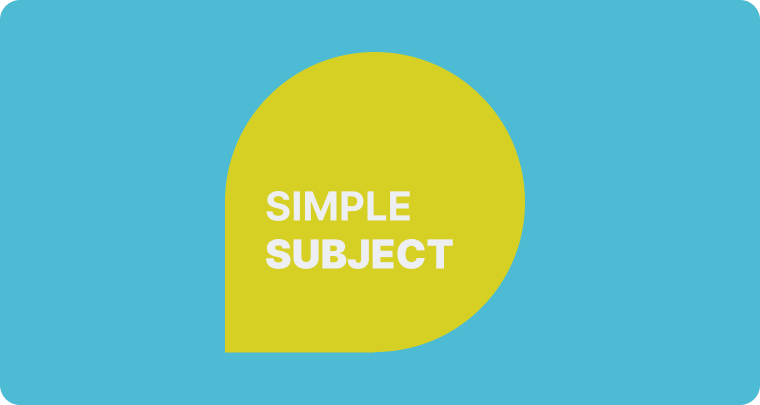
What Is a Simple Subject?
In sentence structure, the simple subject plays a crucial role. It identifies the person or thing performing the action and determines whether the verb should be singular or plural. Let’s dive into its definition and how to spot it in a sentence.
Defining a Simple Subject
A simple subject is the fundamental noun in a sentence, stripped of any descriptive words such as adjectives or articles. For example:
The fat cat pats the mat.
Here, the simple subject is cat. While the full phrase the fat cat includes an article (the) and an adjective (fat), the subject itself is just cat.
Although simple subjects typically consist of a single word, proper nouns and compound nouns may be made up of multiple words.
China’s Three Gorges Dam is the largest power plant in history.
In this sentence, Three Gorges Dam is the simple subject since it is a proper noun. The word China’s is not part of the simple subject, as it serves only to provide additional detail.
Certain sentence types can include more than one simple subject. For instance, in compound sentences, multiple subjects are often connected by conjunctions like and.
My father and I enjoy watching others play catch.
In imperative sentences, which issue commands, the subject is often implied rather than explicitly written.
[You] Turn left to reach Main Street.
Simple Subject vs. Complete Subject
A simple subject is just the noun performing the action, while a complete subject includes the simple subject along with all its descriptive elements.
The red candies that taste like strawberries at the end of the shelf are my favorite.
Here, the complete subject is the red candies that taste like strawberries at the end of the shelf, while the simple subject is only candies.
The Role of Simple Subjects in Subject-Verb Agreement
The simple subject is crucial for ensuring correct subject-verb agreement. Whether the subject is singular or plural dictates the corresponding verb form.
One dog digs in the dirt.
Many dogs dig in the dirt.
In the first sentence, dog is singular, so it takes digs as its verb. In the second, dogs is plural, so the verb changes to dig. This can sometimes be confusing, as singular verbs in English often end in -s, while plural forms do not.
Longer subjects may include words that make it tricky to determine the correct verb form.
A team of retired, Canadian athletes is leading the competition.
Although athletes is plural, the true subject is team, which is singular, requiring is instead of are. The phrase of retired, Canadian athletes is just extra information modifying team.
Some words, like all or half, can be singular or plural depending on the context. The noun that follows them determines how they should be treated.
Half of the population is under 30 years old.
Half of the people are under 30 years old.
Similarly, sometimes an entire phrase functions as a singular subject, particularly when referring to a concept rather than individual elements.
Millions of dollars is all I need.
Even though millions appears plural, the phrase represents a single amount of money, so the subject is considered singular.
Identifying the Simple Subject
The easiest way to pinpoint the simple subject is by eliminating unnecessary words. While articles (a, an, the) are simple to remove, other modifying elements can be trickier. Words and phrases that are not part of the simple subject include:
Articles (the, a, an)
Adjectives (big, pink, tremendous)
Prepositional phrases (on the table, under the bridge, in the room)
Relative clauses (that…, which…, whose…)
Possessive nouns and adjectives (my, their, Jack’s)
Participial phrases (waiting at the door, hidden in the bushes)
Appositives
Let’s analyze a sentence with a complex subject:
Lurking in the shadows, the old statue in town that overlooks the square, usually a reassuring sight, appears eerie at night.
By removing unnecessary modifiers and descriptive phrases, we reveal the simple subject: statue.
Examples of Simple Subjects
Simple subjects can take on different forms, including common nouns, proper nouns, pronouns, gerunds, and infinitives.
Common noun:
After much discussion, marathons were chosen as the best form of exercise.
Proper noun:
After much discussion, the Boston Marathon was selected as the best way to stay fit.
Pronoun:
After much discussion, it was determined to be the best exercise.
Gerund:
After much discussion, running was chosen as the best way to stay in shape.
Infinitive:
After much discussion, to run a marathon was deemed the best fitness challenge.
Frequently Asked Questions
What is a simple subject?
A simple subject is the primary noun in a sentence that performs the action, without any extra descriptive words. For example, in The fat cat pats the mat, the simple subject is cat.
How does a simple subject differ from a complete subject?
A simple subject consists of only the core noun, while a complete subject includes that noun along with all words that modify or describe it. In The fat cat pats the mat, the complete subject is the fat cat, while the simple subject is just cat.
How can I identify the simple subject in a sentence?
To locate the simple subject, remove all unnecessary words such as articles, adjectives, prepositional phrases, relative clauses, possessive nouns/adjectives, participial phrases, and appositives.
